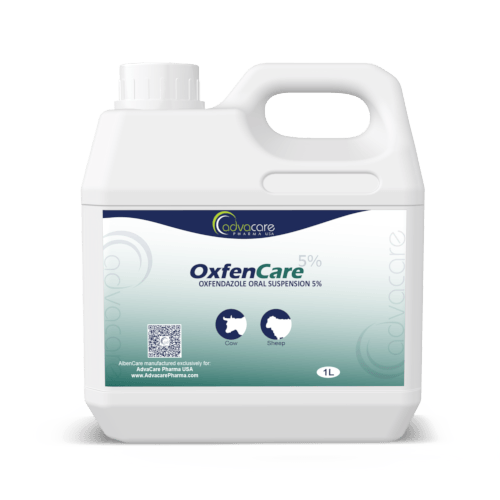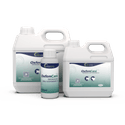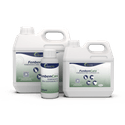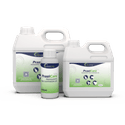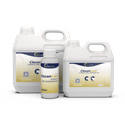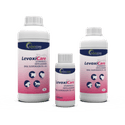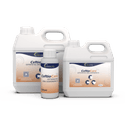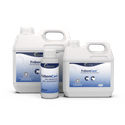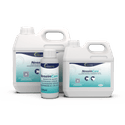- Home›
- Veterinary Pharmaceuticals›
- Veterinary Solutions and Suspensions›
- Veterinary Oral Suspensions›
- Oxfendazole Oral Suspension
Oxfendazole Oral Suspension
Dosage
Packaging
What is Oxfendazole?
Active Ingredients: Oxfendazole
Oxfendazole Oral Suspension is an anthelmintic drug used to treat and control parasitic infections in cows, horses, pigs and sheep. It is effective against roundworms, such as Ancylostoma, Toxocara, Trichuris, and Uncinaria. This dewormer is also active against tapeworms like Echinococcus, Dipylidium, and Taenia.
Oxfendazole is a synthetic anthelmintic that is a benzimidazole derivative. It works by inhibiting the microtubules from using glucose, which eventually leads to the worm's death.
It is important to note Oxfendazole Oral Suspension is for veterinary purposes only.
It is used in treating nematodes and trematodes in domestic animals, and they also have limited activity against cestodes. Benzimidazoles have a broad spectrum of activity against roundworms (nematodes) and a wide safety margin.
Benzimidazoles are soluble in water and can be given orally. Each animal has its own extent of absorption in the gastrointestinal tract. Factors that contribute to the absorption are: species, formulation, dosage, solubility, and esophageal groove reflex. Out of all benzimidazoles, oxfendazole has the longest half-life, enhancing its role and efficacy against immature and arrested larvae and adult nematodes, including lungworms. Anthelmintic drugs undergo a complex journey within the body, including absorption into the bloodstream and distribution to various body parts, including the liver. In the liver, metabolic processes occur and eventually leave the body through feces and urine. Some parasites reside in the lumen and some in the lungs, so absorption from the gastrointestinal tract is needed.
Benzimidazoles have the best effect on horses and ruminants because they have slower passage because of the rumen and cecum.
To achieve the best effect, extended contact time is recommended. More frequent oral administration of a total dose at 12-hour intervals and extending the exposure period with more-soluble drugs bring better results even against benzimidazole-resistant worms. High oxfendazole intake will lead to high oxfendazole concentrations. During treatment with benzimidazoles, reduced feed intake is recommended to slow the flow rate of digestion.
Oxfendazole has a major route of exposure through biliary metabolites, then enterohepatic passage, and absorption from the small and large intestines. Sheep have higher plasma concentrations of oxfendazole compared to goats and cattle due to the higher oxidative metabolic capacity in cattle and goats.
This medication is also available in a bolus form and has the same anthelmintic compound and effect.
AdvaCare Pharma's Oxfendazole Oral Suspension is manufactured in GMP-certified facilities located in China, India, and the USA. We routinely inspect our production facilities to ensure our products meet health, safety, and environmental standards.
Why are we a leading Oxfendazole manufacturer?
AdvaCare Pharma is a GMP-certified manufacturer of Oxfendazole Oral Suspension for veterinary use. To ensure that our products meet and exceed our distributors' standards, we conduct routine internal and third-party facility inspections. As an experienced Oxfendazole manufacturer, our highly skilled team of professionals offers comprehensive support that extends throughout the entire process, including document and registration assistance.
Uses
What is Oxfendazole used for?
It is used to treat parasitic infections caused by roundworms and tapeworms.
Oxfendazole binds to tubulin, the structural protein of microtubules, which leads to the emptying of the glycogen reserves. This leads to paralysis or death of worms.
What animals can be treated with Oxfendazole Oral Suspension?
This medicine is recommended for horses, pigs, cows, and sheep.
How is Oxfendazole Oral Suspension used?
This medicine has been manufactured as a liquid suspension, which is intended to be administered orally.
Why is oxfendazole used in ruminants?
This benzimidazole derivative will remove most adult gastrointestinal parasites and many larvae. The oxidative metabolism is more extensive in cattle than in sheep, and also the excretion is more extensive. The doses are always higher in cows because the systemic anthelmintic activity in sheep is better. This medicine is effective against Dictyocaulus viviparus, the fourth-stage larvae of Ostertagia spp. It has a minimal teratogenic effects in sheep.
Many ruminants with roundworms have resistance to all benzimidazoles, but this is a more frequent case for sheep.
Oxfendazole has a limited residual effect, and one administration can kill the parasites and protect animals from further infestations. However, this prevention only lasts for a short time, and repeated administration is needed.
Up to 50% of the administered dose is absorbed into the bloodstream, but the absorption depends on the passage speed through the rumen. Slower passage leads to higher absorption. A slower passage means longer therapeutic effect of oxfendazole. The excretion of the metabolites is through bile and feces, and only negligible excretion through milk. Cattle might need more frequent administrations compared to goats and sheep.
Heavy infestations lead to pH imbalances in the abomasum and intestines, which can lead to lower therapeutic effects.
Why is Oxfendazole used in cows?
Oxfendazole has a broader spectrum of activity against nematodes, unlike other benzimidazole derivates. It is also effective against tapeworms. Against Fasciola hepatica, higher dosages are needed.
For better effect, you should limit the access to feed, especially fresh pasture, 24 hours before and 6 hours after administration. Very sick, weak, and pregnant animals should have normal food access before administration due to their current health status.
Why is Oxfendazole used in sheep?
Oxfendazole in sheep is effective against all stages of gastrointestinal nematodes, including Nematodirus spp.
Why is Oxfendazole used in horses?
Oxfendazole in horses is used for treating Strongyloides westeri and Oxyuris equi.
Why is Oxfendazole used in pigs?
In pigs, this drug is used for treating Ascaris suum.
What are the specific methods of oxfendazole administration in animals?
Almost all benzimidazole compounds are given orally due to their general insolubility. Oxfendazole can be administered with an intraruminal injector, but it can reduce its bioavailability and efficacy. This prevents the oesophageal groove closure that can lead to therapeutic failure. But this is only in rare cases and should be applied by vets only when needed.This drug should only be administered orally.
How should Oxfendazole Oral Suspension be stored?
This medication should be stored in a dark, dry location under 30°C.
Is there a withdrawal period after treatment with Oxfendazole?
The withdrawal time for meat is 7-14 days. The time of withdrawal depends on the country’s regulatory requirements. It must be followed to prevent food residues and consequent public health implications.
Dosage
How much Oxfendazole Oral Suspension should be given to cows?
The usual dose is 4.5mg Oxfendazole per kg of body weight. The maximum dosage is 5ml per 100kg of body weight in cattle. Do not exceed this dose.
How much Oxfendazole Oral Suspension should be given to sheep?
The usual dose is 5.0mg Oxfendazole per kg of body weight. The maximum dosage is 1ml per 17kg of body weight in sheep. Do not exceed this dose.
Higher dosages of benzimidazoles can lead to teratogenic effects in sheep. The most common congenital defects in lambs are skeletal malformations in the long bones, pelvis, joints, and digits.
Higher dosages of benzimidazoles have the worst side effects in the third week of gestation, especially on the 17th day. The usual dose that causes side effects is the one that is 2 times higher than the normal dose. Some studies show teratogenic effects due to high dosages, but some studies show no such effects. There is a species difference, and each animal shows different side effects.
The dosage depends on the animal’s current condition, species, weight, and age.
Refer to a veterinary doctor or pharmacist for guidelines on dosage.
Side Effects
As with all pharmaceuticals, some unwanted effects can occur from the use of Oxfendazole Oral Suspension.
Serious side effects may include allergy or hypersensitivity reactions. Other side effects include nausea, vomiting, or dizziness. However, the report of the side effects is minimal.
Observe the animal carefully after Oxfendazole Oral Suspension administration. The most serious side effects are visible within minutes. If you observe some unusual changes, contact a professional to manage the problem as soon as possible.
For a comprehensive list of all possible side effects of this medication, consult a veterinarian.
Precautions
Do NOT use Oxfendazole Oral Suspension for an animal that:
- has a known allergy or hypersensitivity to any of the ingredients.
- is an ewe producing milk for human consumption.
Do not limit food intake in pregnant, heavily infested, and sick animals before administering Oxfendazole.
Never administer two doses at once nor extra doses to an animal. If a dose is missed, skip that dose and continue with the next dose at the scheduled time.
What are the most common animals Oxfendazole Oral Suspension is used for?
Oxfendazole is primarily used for treating nematode and trematode infections in domestic animals.
Cows, Sheep, and Goats Parasitic Treatment
Oxfendazole is effective against fourth-stage larvae of Ostertagia spp, Dictyocaulus viviparus, Fasciola hepatica, liver flukes, and Moniezia spp.
Horses Parasitic Treatment
Oxfendazole is effective against Strongyloides westeri and Oxyuris equi.
Swine Parasitic Treatment
Oxfendazole is effective against Ascaris suum in pigs.
The intention for use should be determined by a professional veterinary doctor based on the diagnosis. When needed, this drug should be combined with other drugs and supplements for a full recovery.

You might be interested in...
Why AdvaCare Pharma?
As an industry leader, we are aware of our responsibility to provide affordable and sustainable solutions to improve healthcare worldwide.

